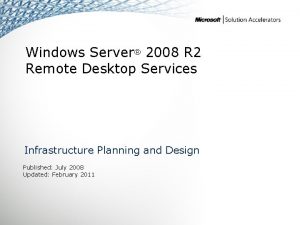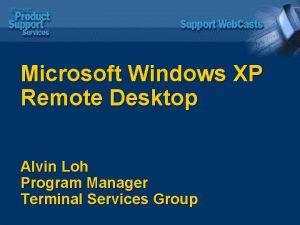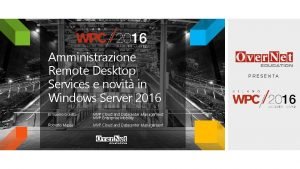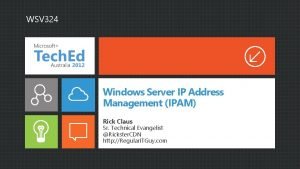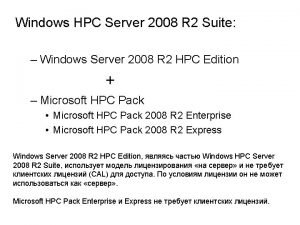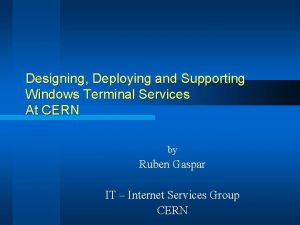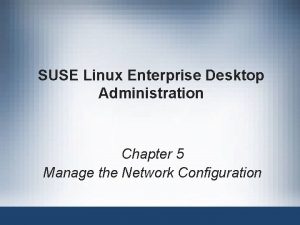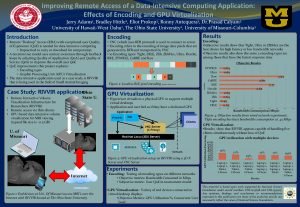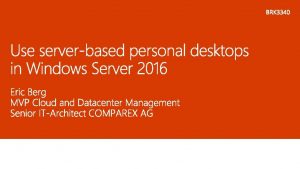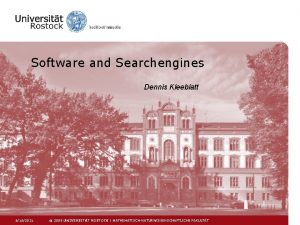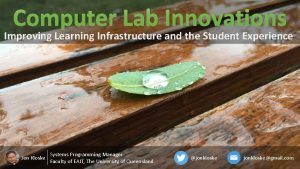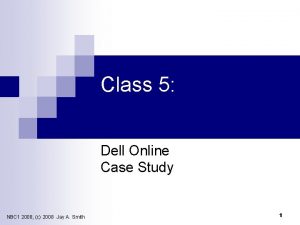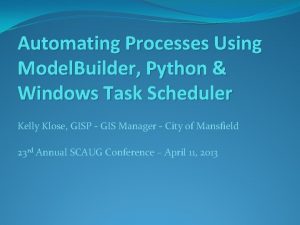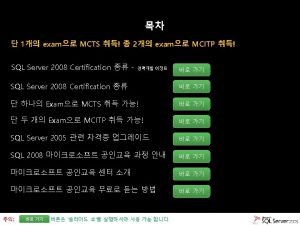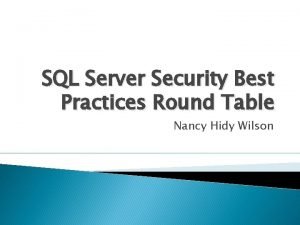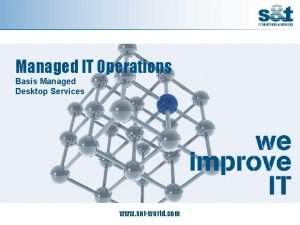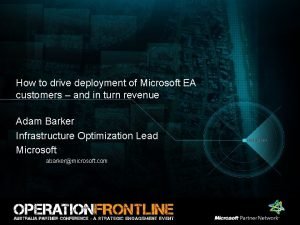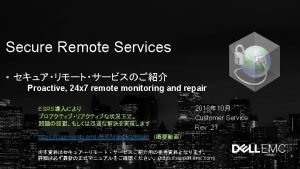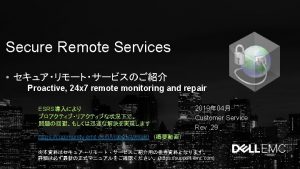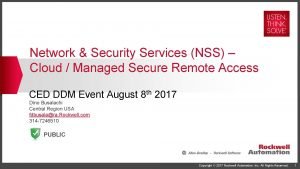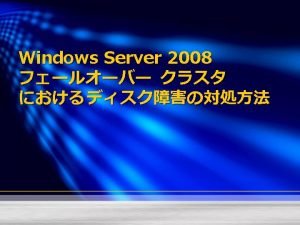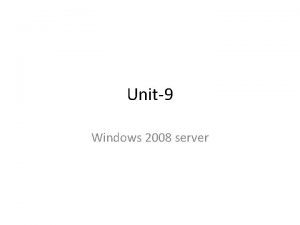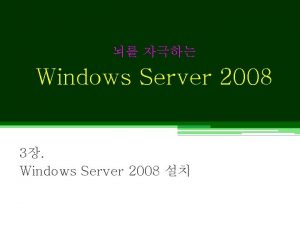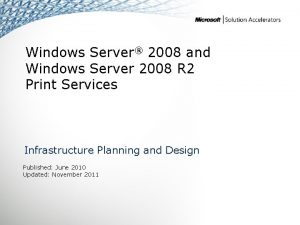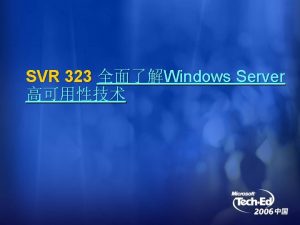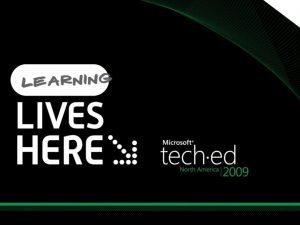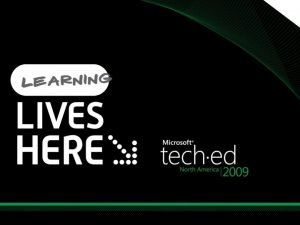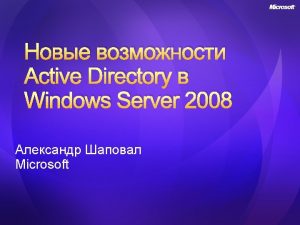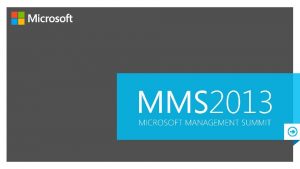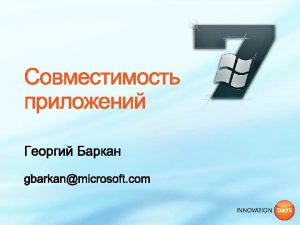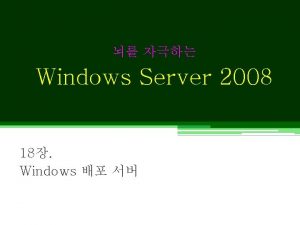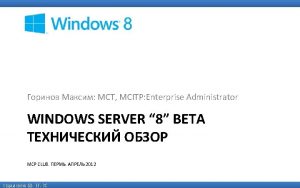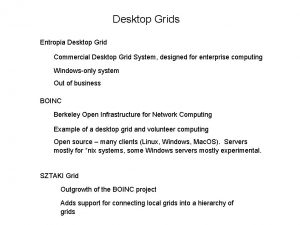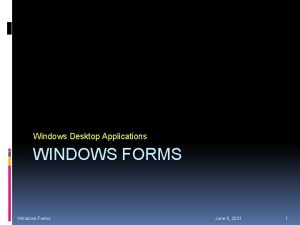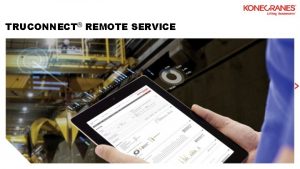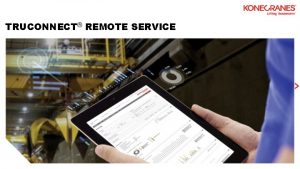Windows Server 2008 R 2 Remote Desktop Services



























- Slides: 27

Windows Server® 2008 R 2 Remote Desktop Services Infrastructure Planning and Design Published: July 2008 Updated: February 2011

What Is IPD? Guidance that clarifies and streamlines the planning and design process for Microsoft® infrastructure technologies IPD: • Defines decision flow • Describes decisions to be made • Relates decisions and options for the business • Frames additional questions for business understanding IPD guides are available at www. microsoft. com/ipd

Getting Started Windows Server® 2008 R 2 Remote Desktop Services

Purpose and Overview Purpose • To provide guidance for designing a Remote Desktop Services infrastructure Overview • Remote Desktop Services features • Remote Desktop Services infrastructure design process

Remote Desktop Services Overview • Session-based presentation virtualization segment of Microsoft’s virtualization technologies • Enables centralized application management • Provides connection brokering for VDI

What’s New in Windows Server 2008 R 2 Remote Desktop Services In Windows Server 2008 R 2, Remote Desktop Services (formerly named Terminal Services) role services have been renamed as shown in this table.

Windows Server 2008 R 2 Remote Desktop Services Architecture Example SCM ITA

Remote Desktop Services Decision Flow MAP w/ CAL Tracker SCM ITA

Step 1: Determine the Scope of the Remote Desktop Services Project • Task 1: Determine organizational scope • Enterprise-wide, one or many locations, or just a single department

Step 2: Determine How Workloads Will Be Delivered • Task 1: Gather information about users and their working environment • Task 2: Determine whether the workload can be delivered using presentation virtualization

Step 2: Determine How Workloads Will Be Delivered (Continued) • Task 3: Decide whether the workload can be delivered from an RD Session Host or using VDI • Task 4: Categorize users

Step 3: Determine the Number of RD Session Host Server Farms • Task 1: Determine the number of RD Session Host server farms

Step 4: Map Workloads and Users to Farms • Task 1: Assign workloads and users to their RD Session Host server farms

Step 5: Design the Farms • Task 1: Select a form factor for the RD Session Host server • Task 2: Determine the number of RD Session Host servers required in the farm • Task 3: Determine the number of additional servers required for fault tolerance

Step 6: Determine Where to Store User Data • Task 1: Design user profiles • Task 2: Design user data • Task 3: Design the storage

Step 7: Size and Place the Remote Desktop Services Role Services for the Farms • Task 1: Design and place the RD Connection Broker role service • Task 2: Determine the number of servers required for RD Web Access

Step 7: Size and Place the Remote Desktop Services Role Services for the Farms (Continued) • Task 3: Design and Place the Remote Desktop License Servers • Task 4: Design and Place the RD Gateway Servers

Step 8: Secure the Communications • Task 1: Determine the encryption level • between clients and the RD Session Host • server • Task 2: Determine whether to seal the communications • Task 3: Determine the certification authority • Task 4: Determine whether to encapsulate • with HTTPS

Step 9: Design VDI and the RD Virtualization Host Role • Start by deciding how VDI desktops will be provided • Determine the most appropriate type of hardware on which to deploy the RD Virtualization Host servers • Decide how many will be required

Summary and Conclusion • The Remote Desktop Services guide has addressed the fundamental decisions and tasks involved in: • Deciding what workloads are to be delivered by Remote Desktop Services and whether Remote Desktop Services is the right approach to use • Determining the resources needed to employ Remote Desktop Services to serve the selected workloads • Designing the components, layout, security, and connectivity of the Remote Desktop Services infrastructure • Provide feedback to ipdfdbk@microsoft. com

Find More Information • Download the full document and other IPD guides: www. microsoft. com/ipd • Contact the IPD team: ipdfdbk@microsoft. com • Access the Microsoft Solution Accelerators website: http: //www. microsoft. com/technet/Solution. Accelerators

Questions?

Addenda: • Benefits for consultants or partners • IPD in Microsoft Operations Framework 4. 0 • Remote Desktop Services in Microsoft Infrastructure Optimization

Benefits of Using the Remote Desktop Services Guide • Benefits for Business Stakeholders/Decision Makers – Most cost-effective design solution for implementation – Alignment between the business and IT from the beginning of the design process to the end • Benefits for Infrastructure Stakeholders/ Decision Makers – Authoritative guidance – Business validation questions ensuring solution meets requirements of business and infrastructure stakeholders – High integrity design criteria that includes product limitations – Fault-tolerant infrastructure – Infrastructure that’s sized appropriately for business requirements

Benefits of Using the Remote Desktop Services Guide (Continued) • Benefits for Consultants or Partners – – Rapid readiness for consulting engagements Planning and design template to standardize design and peer reviews A “leave-behind” for pre- and post-sales visits to customer sites General classroom instruction/preparation • Benefits for the Entire Organization – Using the guide should result in a design that will be sized, configured, and appropriately placed to deliver a solution for achieving stated business requirements

IPD in Microsoft Operations Framework 4. 0 Use MOF with IPD guides to ensure that people and process considerations are addressed when changes to an organization’s IT services are being planned.

Remote Desktop Services in Microsoft Infrastructure Optimization
 Remote desktop virtualization host role server 2012
Remote desktop virtualization host role server 2012 Windows xp remote desktop service
Windows xp remote desktop service Remote desktop services diagnostic tool
Remote desktop services diagnostic tool Windows server 2008 ip address management
Windows server 2008 ip address management Windows hpc server
Windows hpc server Ucl one drive
Ucl one drive Cernts
Cernts Suse linux remote desktop
Suse linux remote desktop Remote desktop computationally intensive application
Remote desktop computationally intensive application Nau virtual desktop
Nau virtual desktop Stanford remote desktop
Stanford remote desktop Uni rostock remote desktop
Uni rostock remote desktop Uq eait remote desktop
Uq eait remote desktop Dell 2008 desktop models
Dell 2008 desktop models 2008 2008
2008 2008 Setup windows xp virtual machine
Setup windows xp virtual machine Te desktop download for windows
Te desktop download for windows Python windows automation
Python windows automation Redis remote dictionary server
Redis remote dictionary server Sql server 2008 certification
Sql server 2008 certification Sql server 2008 management studio express
Sql server 2008 management studio express Sql server 2008 auditing best practices
Sql server 2008 auditing best practices Managed desktop services
Managed desktop services Desktop deployment planning services
Desktop deployment planning services Esrs ve
Esrs ve Dell secure connect gateway
Dell secure connect gateway Network security services nss
Network security services nss Microsoft windows small business server 2011 essentials
Microsoft windows small business server 2011 essentials
